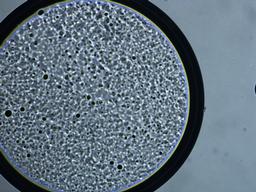Development of Novel Microfoams with Reduced Compressibility by Tailored Dispersing and Interfacial Pickering Stabilization
Fabian Birbaum
Background
The availability of the Earth’s natural resources are decreasing. The consequences are that the resources prizes is increasing, because of higher productions costs and a higher demand on the commodities exchange. The industry has therefore a demand to develop new products and processing technologies to reduce the amount of the natural resources used what correlates with a lower production cost. One approach to reach this goals is to fix air in the products without changing their properties. This is the point this research project is involved.

Aim of the Thesis
For a lot of products in the food and nonfood section, there is a need to save resources that the costs of the products can be decreased or in a worst case stabilized on a low level. One approach to reach this, is to fix air in the products, in other words to produce foams. This foamed products should not have worse properties than the original products. At this point my project is starting. The goal is to produce incompressible foams and for that a new production process has to be developed as well. A promising way is well known from Pickering emulsions. The challenge of transforming this Pickering stabilization to foams in this project is difficult, since the whole system is highly viscous.
Theory
The stabilization of Pickering emulsions is based on particle-interphase interaction. The contact angle of the particles play the major role whether the emulsion is stabilized or destabilized or which phase is the inner and which is the outer. The most stable emulsion is reached with at least one complete layer of particles around the droplet. A multiple layer can stabilize the droplet even better. A well known product where particle stabilizes the emulsion is a salad dressing. The oil and vinegar are completely not mixable, the pepper and other particles stabilize the whole system. For foams only few products existing right now. One is ice cream, where the air is stabilized by crystals in the fat. One of the biggest challenge of this project is the viscosity of the system. Since the velocity of the particles in the fluid is depending on the viscosity and the size respectively on the particle shape. So fare only foams with a low viscose fluid phase were stabilized.
Work in Process
- real-time computed tomography
- interfacial rheology
Bachelor-, Masterthesis
New: Masterthesis in the field of Rheologie and real-time computed tomography (CT) to investigate complex flow behavior in extrusion dies.
Begin: April
Referenzen
- Binks, P. B. (2002), Particles as surfactants - similarities and differences, Current Opinion in Colloid & Interface Science, vol. 7 p. 21-41, external page DOI
- Binks, P. B. (2005), Aqueous Foams Stabilized Solely by Silica Nanoparticles, Angewandte Chemie, vol. 117 p. 3788-3791, external page DOI
- Dickinson, E. (2010), Food emulsions and foams: Stabilization by particles, Current Opinion in Colloid & Interface Science, vol. 15 p. 40-49, external page DOI
- Gonzenbach, U. T. (2006), Stabilization of Foams with Inorganic Colloidal Particles, Langmuir, vol. 22 p. 10983-10988, external page DOI
- Horozov, T. S. (2008), Foams and foam films stabilised by solid particles, Current Opinion in Colloid & Interface Science, vol. 13 p. 134-140, external page DOI
- Pickering, S. U. (1907), CXCVI.-Emulsions, J. Chem. Soc. Trans., vol. 91 p. 2001-2021, external page DOI
- Tcholaova, S. (2008), Comparison of solid particles, globular proteins and surfactants as emulsifiers, Phys. Chem. Chem. Phys., vol. 10 p. 1608-1627, external page DOI
Contact
No database information available